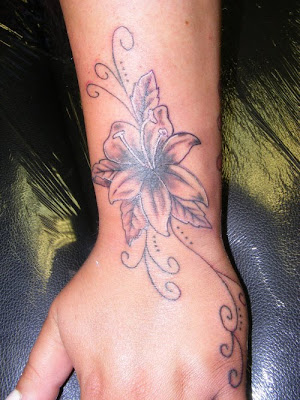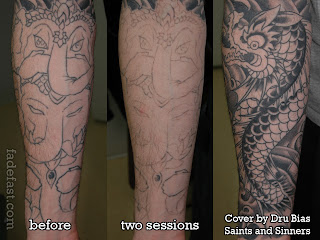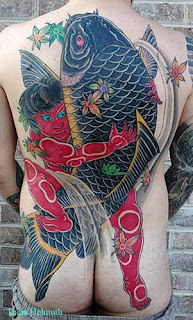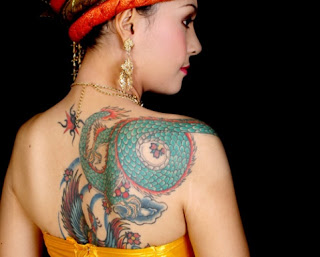 Matching swallow birds.
Matching swallow birds.
|
|
|---|
Tuesday, August 31, 2010
Cute Hand Tattoos
This collection of hand tattoos is chalked full of fun, silly and cute artwork ideas for both boys and girls of any age. I imagine you'll take an immediate liking to the little hand goblin, and you would be right for doing so, he's a lot of fun!
 Matching swallow birds.
Matching swallow birds.
 Matching swallow birds.
Matching swallow birds.Hand Tattoos For Girls
As we mentioned before, hand tattoos are often regrettable because they are not easy to disclose when needed, however it does seem like girls hand tattoos in general are much less subtle and perhaps more appealing to people whose fear the wraith of an inked man or woman.
 Rose hand tattoo with ladybug.
Rose hand tattoo with ladybug. Lovely flower on wrist area.
Lovely flower on wrist area. Picture of three small stars.
Picture of three small stars.
 Rose hand tattoo with ladybug.
Rose hand tattoo with ladybug. Lovely flower on wrist area.
Lovely flower on wrist area. Picture of three small stars.
Picture of three small stars.
Hand Tattoos
Much like facial tattoos, getting a tattoo on your hand is also a rather daring choice of location which is somewhat difficult to hide for those formal occasions. Perhaps not quite as difficult as covering your face, but still its a pretty risky and often regrettable tattoo area.
Checkout these pictures of some real top quality hand artwork ideas below.
 Matching lotus flowers.
Matching lotus flowers.
Checkout these pictures of some real top quality hand artwork ideas below.
 Matching lotus flowers.
Matching lotus flowers.Monday, August 30, 2010
Frequently Asked Questions About Laser Tattoo Removal Procedures
Tattoo art has gained immense popularity over the last decade. With this rise in the number of tattooed people, also comes a rise in the number of cases of tattoo regret. Right now there are over 45 million Americans with at least 1 tattoo. Studies and polls have shown that between 17%-50% of those asked experience some tattoo regret. Luckily for them, it's never been easier, safer, or more affordable to effectively remove an unwanted tattoo. Primarily, this can be attributed to advances in laser technology.
Laser tattoo removal is a rapidly growing industry. However, the concept (and procedure) is still new to many people. What follows is an overview of some of the most common frequently asked questions (FAQs) about laser tattoo removal:
1. How does the laser procedure remove the tattoo?
A: Basically, the laser focuses an intense beam of light (laser) energy on the tattoo, which breaks up the tattoo ink pigment into tiny fragments. These fragments are then absorbed and flushed out naturally by the body over the next several weeks following treatment. Current laser technology allows providers to target the ink without harming the surrounding skin and tissue cells - so healing is quick and scarring is extremely rare.
2. Is the procedure painful?
A: Many people compare the pain associated with removal as being similar to the level of pain of getting the tattoo in the first place. However, it's a different type of pain. The impact of the laser pulse is often compared to the feeling of snapping a rubber band on the skin. The good thing is that it takes significantly less time to remove a tattoo than it did to apply it! Many providers also offer some type of service to help with the pain of the procedure - most commonly topical numbing agents (such as lidocaine) or cooling agents (e.g. ice pack or a cryo-cooler).
3. How many treatment sessions does it take to remove a tattoo?
A: This depends on a persons skin as well as the tattoo itself (the age of the tattoo, the density of the ink, the type and amount of ink used, color of the ink, the depth of the ink in the skin, the location of the tattoo, and how the tattoo was applied). Most professionally applied tattoos take from 5 to 12 treatments to remove completely. Homemade tattoos usually take less (1 to 6 treatments). If you just want your tattoo lightened to cover-up with new tattoo art, then it will take significantly less treatments (1 to 4 usually).
4. How long do you have to wait in between treatments?
A: Treatments are typically spaced 4-6 weeks apart. Your body needs time to heal properly and flush the ink out.
5. Can a tattoo be completely removed?
A: In many cases, yes. However, 100% removal cannot be promised. Different types of ink respond differently to the laser procedure. Black and red inks are usually the easiest to remove. Some light blues and light greens are tougher to remove. Also, it's hard to tell what additives are contained in any given ink by any given manufacturer, so not all inks respond the same.
6. Will there be any scarring?
A: As long as your provider is using an FDA approved laser for tattoo removal, there is very little chance of any scarring. Today there are numerous lasers (the most common types are q-Switched Nd:YAG or ruby) that are developed and manufactured specifically for tattoo removal. These lasers typically don't penetrate deep enough into the skin to cause scarring. Also, the pulse from these lasers only affects the tattoo ink pigments, not the surrounding cells and tissue. Most scarring risk comes from improper aftercare on part of the patient during the healing process after a procedure. However, people with a history of keloid scarring can be at greater risk for scarring, and should discuss this with their provider before any laser treatment.
7. What side effects are common?
A: Most removal side-effects are similar to when the tattoo was applied. Patients commonly experience some swelling, redness after a treatment. Some can also experience blistering of the skin. These effects are temporary and your skin will heal completely.
8. Who is qualified to perform this procedure?
A: State regulations vary. However, you want to at least be sure that your provider is a Certified Laser Specialist or Laser Safety Officer, who preferably has received advanced tattoo removal training. You also want to be sure that your provider is using a laser that has been FDA approved for tattoo removal. Be wary of any provider using a "multi-use" laser as different laser procedures (hair removal, laser lipo, tattoo removal, etc) all have different types of recommended lasers or laser wavelengths. There is no one machine that can effectively and safely perform all these different procedures.
feminine zodiac Tattoo Girls
I thought it would be next to impossible to find a collection of one-of-a-kind tattoos as I would have to trudge through God knows how many websites but to my amazement, I couldn’t have been more wrong. Some words of wisdom from my good buddy Jerry Chuan finally set me on the right path and helped me accomplish my mission with relative ease. Here are some tips that you should do well to remember when looking for unique Libra tattoos:

Chuan showed me the error of my ways so to speak, and made me realize that “free” and “unique” do not go hand in hand. Spending a tad amount of cash can really go a long way in helping you secure a design that will be a part of your body for the rest of your life. You wouldn’t want to fork out your hard-earned bucks for a laser surgery or cover-ups, right? Of course not! You’re better off spending the extra dough on a large pizza (sorry, can’t resist the pun) with all the trimmings to celebrate the end of your search for unique Libra tattoos.
How to Tattoo For Beginners
If you decide you want to become an tattoo artist. it is more than just ordering a tattoo kit through a tattoo magazine, or website. or even your friends allowing you to start experimental tattoos on them! The art of tattooing, is an ancient art form, with a set of rules that must be understood fully if you are going to succeed as an tattoo artist.
If you fail to understand and respect these rules, this will not only result in a botched up piece of art work, but the results can often lead to the transmission of deadly diseases, followed by lawsuits, that could invariably run into millions of dollars. Remember, you do not want to have a bad reputation as a 'scratcher' when you first start out!
It takes a great deal of time, effort, and money to become a tattoo artist. However, it does help if you have some training in art, or you are good at drawing. This enables you to have an understanding of form and colour technology. The positive side is that, tattooing is an art that can be learned without formal training, and contrary to popular opinion, there are still a few tattooing artists out there who are willing to take on an apprentice, and teach an eager student how to become a tattoo artist.
Training can last from a few months, to a few years, depending on the ability of the student. As with all forms of art training, you have to be able to understand about form and colour, shading, line drawing etc. By mastering these principles, you will surely succeed.
There are also a number of self training DVD's now available throughout the internet, on the subject of 'how to become a tattoo artist'. Further information about tattooing, and learning to tattoo is now available below.
Are Tattoos Safe
A lot of people fear that getting a tattoo is not safe because there are slight chances that you can get infected with Hepatitis B or C as well as HIV or Aids. However, the chances of this happening are rather slim. Tattoos in general are very safe, that is if you choose an appropriate facility that has the proper sterilizing and cleaning equipment and follows all recommended safety precautions you should have no worries.
If you are new at tattooing and have no idea what to look for when it comes to making sure your tattoo parlor is clean and follows the proper health code and guidelines, below is a list of important things you should look for or ask to see to ease your mind.
*Make sure you see an the autoclave and sterilization certification if you don't see it ask to see it. The autoclave is the machine that sterilizes the tattoo equipment.
*Make sure they are wearing gloves. Some sort of latex medical glove should be worn to protect the tattoo artist as well as you from any germs or anything else.
*Ask what kind of training your tattoo artist has had and what kind of certificates that have. There really are no tattoo training programs out there but they should have a license or some sort of certificate from whatever state they are practicing in to make it legal.
*Make sure ointment, ink, water and other items should not be returned to a universal container after it has been removed for use on a client. This is for obvious health reasons. Basically anything a tattoo artist uses on your should be thrown out and anything with blood on it should be put in a bio-hazard container.
*Make sure new sterile needles are always removed from an autoclave bag in front of you. This is to make sure the needle is fresh and clean.
Tattoos - A Living Form of Art
Tattoos and body piercings have grown in popularity over the past few decades. Once only reserved for tribes, sailors, or criminals, the meaning of tattoos and the reasons for people getting them have changed dramatically.
A Brief History
Like body piercings, tattoos are created by the constant application of ink just under the subcutaneous layer of the skin with a needle. At first, many tribes, sailors, and other groups used to apply the ink by hand. This was a long, painful process and the marked people were usually of high status. The tattoos were often a sign of respect, rank, and social status. Since the tattoos are permanent, the owners were guaranteed respect for life.
The interest of tattooing for the general public spread throughout the world in fads. A sailor would bring over a fully tattooed indigenous person and interest would spread like wildfire. In London, a sailor brought over a tattooed Polynesian from the South Pacific, and many of the people of London began to acquire their own small tattoos in secret places. However, interest in tattooing waxed and waned due to its long, arduous process of applying every dot of ink by hand.
The electric tattoo machine is a relatively recent invention, created in 1891 by Samuel O'Reily, and has revolutionized tattoos into an art form. Tattooing can still be long and painful but now the many punctures in the skin are done automatically at thousands of punctures per minute and can allow for better detail and shading. Skin is the most unique canvas and a tattoo that is placed onto the skin is permanent, requiring extra consideration for the right tattoo, the right artist, and the right placement. That piece of art will follow throughout one's lifetime.
In New York City, Samuel O'Reily trained a partner named Charley Wagner, who continued teaching after O'Reily's death. For a brief while, Chatham Square flourished with tattoo artists while the rest of the world remained unimpressed with tattooing. For a long time tattooing was generally stigmatized and most people with tattoos were stereotyped to be scary, dangerous, or freaks. During the 1920s tattoos began to be recognized for where a person has been in their travels, as tattoo artists set up shops in Coney Island. An outbreak of hepatitis, blood poisoning and other disease even worsened the prospects for tattooing in American culture.
Finally, a tattoo artist named Lyle Tuttle changed America's perception of tattooing by introducing celebrities to the art form. He tattooed them, mostly women, and used the media to change their stereotypes about the types of people who got tattoos. Together with the heightened awareness of the importance of sterilization and the improvement of training, tattoo popularity began to surge in the last few decades.
Changing Views
Today, the tattooing industry booms with new talented artists, schools and apprenticeship for budding tattooists, enlightened knowledge about sterilization, and health code regulation. Tattoo suppliers are well known and there are a wide variety of brands to choose from inks, tattoo machines, needles, and even tattoo shop supplies such as flash designs, chairs, and more. Younger generations are catching onto this art form and have made having a tattoo almost a rite of passage when one turns 18 in America. As more and more people of all walks of life have tattoos, the old stereotypes of tattooing that previously kept tattooing underground and unsafe has become outdated.
Now getting a tattoo is easier, mildly less painful, and relatively faster than ever before. The results of sitting in a chair in one position for a few hours are much more satisfying to see a beautiful piece of art with the outbursts of new and unique tattoo artists, each with their own style. Some tattoo designers stick with what is known as Old School tattoos, which have the look of tattoos done before the Second World War. They include traditional designs like nautical stars, pin up girls and mermaids, Old English letters, sparrows, skulls, hearts, roses, symbolic animal spirits (tigers, eagles, fish), and more. Old School tattoos keep the look simple with mostly black ink and a little bit of color because in the older days of tattooing there was not a great variety of ink colors to choose from. Old school tattoos are also notorious for featuring a ribbon with Old English letters writing a word or name inside the papyrus. The infamous Sailor Jerry Collins was the man who designed most tattoos that are now considered traditional or Old School. Today many women interested in 1950s retro fashion choose Old School tattoos and place them on their arm like a sailor would back in the day. Many sailor tattoos are symbolic. For example, the nautical star means that a person has gone through an important event or has been somewhere far and has returned safely.
New School tattoos include any new techniques done after this war. After the 1961 hepatitis outbreak which forced the tattoo movement underground for a while, tattoo designs were picked up by younger generations. They used bold, bright colors and utilized more shading thanks to advancements in needle variety and better quality ink. The health code regulations and better use of sterilization machines brought tattooing back in the forefront again. New school tattoos still have the same list of tattoo designs as old school but are captured in a unique way that is difficult to explain but easy to see the difference. Also many people today get new school designs that are custom made, compared to the old school tattoos which were generally picked off a wall of flash.
Today there are dozens of interesting tattoo styles to choose from: Celtic, Japanese, religious, spiritual, tribal, bio-mechanical, feminine, military, black and gray, traditional, neo-traditional, modern, and more. The best part about getting a tattoo is designing a custom piece. Then it is completely unique and meaningful for the person. Today, tattooing is more than ink on skin; it is expression of the soul.
Break the Tattoo Taboo at Work
Once upon a time, the only people who had ink were men with lots of facial hair, ex-cons, bikers, and the military. Companies that make you cover your tattoo probably claim visible ink is unprofessional and unbusiness like and that can be true. Some companies such as financial institutions want a buttoned up, serious image. Your grandmother with the purple hair probably hates your tattoos, and she is the customer the bank wants to keep happy, not you. If working for a company like this is an important step in your career or if the pay and benefits are too good to pass up, suck it up, cover up, but do some research. If you are thinking about making this a career step job, invest some time in figuring out how ink can work for the company.
First, does your company want younger, hipper customers just like you? Are you the demographic they want to reach? Could your company benefit from having a younger face to help younger customers feel welcome? Could your ink help you do that?
Second, what is the competition doing? Do their employees have visible ink? Scope out the competition to see what they are doing that your company can do, too.
Second, what is the competition doing? Do their employees have visible ink? Scope out the competition to see what they are doing that your company can do, too.
Third, make your case. Do not disrespect your company or boss. Present a bottomline business case for ink. Show how younger, hipper employees can send a powerful welcoming message to young, hip, new customers, and increase market share.
You may lose the first few rounds. Traditional people and institutions change slowly. Sometimes it can seem like you are swimming through quicksand. Quicksand is tricky; if you stop struggling, lie flat, then slowly roll, you can get out without drowning. Take your time, do your homework and present your business case. If you do a good job, and the rules against ink are lifted, congratulations! You have won the first of probably many battles.
What if all your work does not pay off, and ink is still out? Decide to stay or go. If you stay, cover up. If you go, use your ink to take the temperature of a prospective employer.
Patricia Haddock is a communications consultant and trainer with more than 20 years of business writing experience. She teaches business writing and professional development workshops.
Patricia has authored more than 600 magazine articles and 11 books, including The Time Management Workshop - AMACOM, Leadership Skills for Women -- Crisp Learning, Developing as a Professional - Crisp Learning, Office Management: A Productivity and Effectiveness Guide -- Crisp Learning.
Tribal Sleeve Tattoos
Tribal sleeve tattoos are almost always seen in the form of the classic arcs and curves, which come in all shapes, sizes, widths and lengths, sometimes all of which are connected at some point.
These tattoo pictures below are a great collection of high quality tribal sleeve ideas for either girls or guys, however tribal sleeve tattoos in general are much more commonly seen on men.

These tattoo pictures below are a great collection of high quality tribal sleeve ideas for either girls or guys, however tribal sleeve tattoos in general are much more commonly seen on men.

Subscribe to:
Posts (Atom)













































